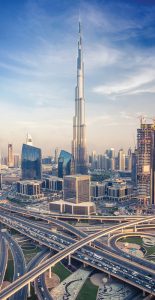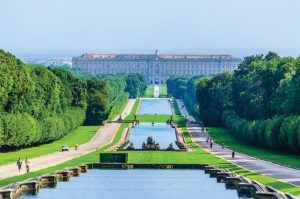I would like to discuss the idea of “big” structures and explore some interesting facts about these landmark structures that have defined the egocentric ambitions of countries, rulers, and people.
What is Big? Developers, builders, architects, engineers, and the public have been pondering that question for thousands of years. From the Egyptian Pharaohs that wanted us to remember them through their Pyramids to today’s modern high rise buildings, there is apparently a demand within the human psyche to be the “Biggest.” This race started in the 1930s with the Chrysler Building (1,046 feet height, 1.195 Million square feet [MSF], built in 1930) and the Empire State Building (1250 feet, 2.25 MSF, built in 1931), to the current title holder, Burj Khalifa (2717 feet tall, 3.31 MSF, completed in 2010). But wait, the race never ends! There is a host of new contenders on the horizon to take the title of “World’s Tallest” every year.
I became intrigued with the topic of “Big, Tall, Large” after a recent trip to Romania, where I visited and toured the Palace of Parliament Building (Parliament Building) in Bucharest. The City’s claim that this is the second largest government building (3.95 MSF) peaked my curiosity, and I had to go for a tour of the facility. I learned that the U.S. Pentagon tops out at 6.5 MSF and is the world’s largest government building. Comparing these two structures with the Burj Khalifa and several other high-rise buildings, the concept of “Big” gets blurred very quickly. If we look at floor area, the largest building is the New Century Global Center (18.9 MSF) in Chengdu, China, with the Dubai Airport Terminal (18.44 MSF) not far behind.
So why this fascination with being the “Biggest?” The simple answer: Ego. Governments around the globe are no different from children at play with blocks. As children, we used to play with Legos®/blocks and try to make a really tall tower and proceed to show off our “Tallest” tower. Then, someone would walk by and knock the tower down. This almost sounds like the real world!
Today, we hold Bridge Building Contests, with popsicle sticks and glue as building materials, to see which is the strongest and can hold the most weight. Awards are handed out for these competitions. This seemingly standard educational exercise actually fosters the idea that Big is Best. However, it did not start with our generation; it has been with us for centuries.
The Pharaohs built their Pyramids, not for eternal fame, but to take their treasures with them into the next life. After a few thousand years of pillaging the Great Pyramids, Egyptians learned that making a big statement about your wealth and not following up with security is a bad idea. So, they decided to hide their treasures inside a Tomb, instead of making big landmarks which stood as advertisements to thieves. “Hey, I’ve got a lot of treasures and they are right here.” No doubt, this was a fundamental shift in philosophy from “Bigger is Better” to “Less is More.” I learned these facts after making a personal visit to Cairo, Luxor, and the Valley of the Kings.
Fast forward to the modern world. The developers of the Burj Khalifa and the soon to be constructed Jedda Tower are in direct competition with each other to outdo Bigness. The Chinese aren’t far behind, with massive construction projects underway in Shanghai, Beijing, and Hong Kong. Governments, nations, and wealthy individuals have an urge to create their “space,” an area that defines their existence and proclaims their identity for future generations. In my opinion, it’s an attempt at immortality. There are a few of us who would like someone to remember us when we are no longer here and say, “Oh wow, that was a Good Dude,” or something like that.
Nowhere does this become more relevant than in personal residences. One of the world’s largest residential spaces is the Royal Palace of Caserta (2.53 MSF, Naples, Italy) and outstrips the Palace of Versailles (720,000 sq. ft.) by three times, even though it is not as famous.
It’s hard to believe that one palace for one family is larger than the Empire State Building. They must have a lot of cousins! In contrast, the White House is just a tiny 54,900 square feet.
As I went on my tour of the Parliament Building in Bucharest, I was amazed that out of almost 4 MSF, only about 20% of the building was in actual use. The rest of it was cold, uninhabited, and suffering from neglect. The tour guide admitted that the expense of heating and lighting the building exceeds the Government’s budgetary capacity. I learned that the purpose of the Parliament Building was to satisfy the egocentric objectives of its former ruler, Nicolae Ceausescu, who wanted to make this building his personal residence. Unfortunately, he was a brutal dictator that exploited his country’s resources to complete his fascination and, in the end, was overthrown and shot by firing squad.
In the final analysis, what does this all mean for Structural Engineers, Architects, Designers, Builders, and Design Professionals? We all know that each one of these examples creates a plethora of design issues, problems to be solved, and construction difficulties that have been resolved through years of toil, torment, and thought-provoking Saturday evenings by many engineers, architects, and builders several times over. People have an urge to be famous for one reason or another, whatever that may be. And, successful people have a special desire to out-do, out-build, out-perform, and outshine other successful people in whatever category they can find. After many international tours to some fascinating destinations and visits to landmark structures, I have learned that it is not what is “Big” that matters; instead, it is what purpose your life served in the grand plan of making this world a better place. That’s my personal lesson.
However, I have some positive thoughts for developers of large buildings. I want to say Thank You. Thank You to all those egomaniacal personalities that want to create, with their personal signature, the most unique space. If it were not for these individuals, design professionals would simply be busy designing more hospitals and schools. Instead, you make our profession challenging while we fulfill your dreams of immortal grandeur, even though others are always working on something Bigger, Taller, or Larger.▪


